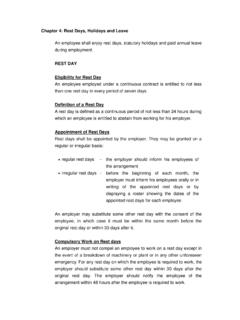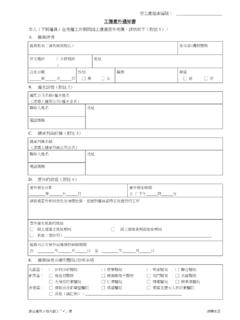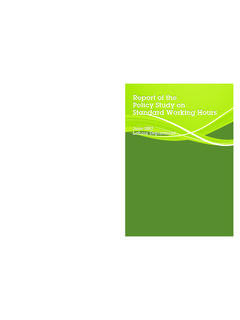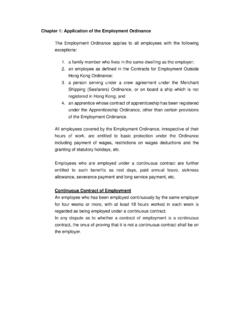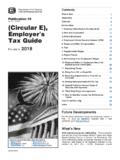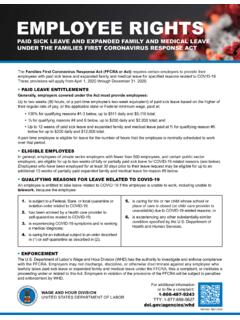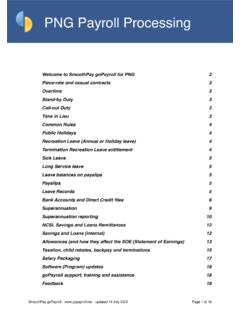Transcription of Appendix 1:A Guide to the Calculation of Relevant ...
1 Appendix 1 A Guide to the Calculation of Relevant Statutory Entitlements on the Basis of the 12-Month Average Wages with Examples Introduction Provisions under the Employment (Amendment) Ordinance 2007 ( the E(A)O 2007 ) relating to the Calculation of statutory entitlements became effective on 13 July 2007(Note 1). The main objective of the E(A)O 2007 is to ensure that all components of wages (Note 2) as defined under the Employment Ordinance (including commission and allowance, etc) are included in the Calculation of Relevant statutory entitlements. Upon commencement of the E(A)O 2007, regardless of whether an employee is monthly, daily or piece rated, his Relevant statutory entitlements shall be calculated on the basis of his 12-month average wages; and in computing his average wages, any periods and wages that fall under the disregarding provisions shall be excluded.
2 (Note 1) Application of the E(A)O 2007: Applicable to employment contracts entered into on or after 13 July 2007. For employment contracts entered into before the commencement date, the E(A)O 2007 is applicable under the following situations: If maternity leave pay, paternity leave pay, sickness allowance, holiday pay or annual leave pay is payable by an employer to an employee in respect of a wage period, and the last day of the wage period falls on or after the commencement date. If the due date of the end of year payment (or proportion of it) payable by an employer to an employee falls on or after the commencement date.
3 If the Relevant statutory entitlements are payable upon termination of contract and the date of termination falls on or after the commencement date. (Note 2) See the part on definition of wages in Chapter 3. (I) Relevant Statutory Entitlements: 1. Holiday pay 2. Annual leave pay 3. Sickness allowance and related provisions (Note 3) 4. Maternity leave pay and related provisions (Note 4) 5. Paternity leave pay 6. End of year payment 7. Payment in lieu of notice (II) The Revised Mode of Calculation : Calculating Relevant statutory entitlements on the basis of the 12-month average wages The Relevant statutory entitlements shall be calculated on the basis of the average daily (or monthly) wages earned by an employee in the 12-month (Note 5) period preceding the specified dates as stipulated by the E(A)O 2007.
4 If an employee is employed for less than 12 months, the Calculation shall be based on the shorter period(Note 6). The specified dates of the Relevant statutory entitlements are: Statutory Entitlements Day(s) of leave Specified Dates Holiday Pay 1 day Day of the statutory holiday More than 1 consecutive day First day of the statutory holidays Annual leave Pay 1 day Day of the annual leave More than 1 consecutive day First day of the annual leave (Note 3) Including the compensation payable by an employer for wrongfully dismissing an employee on sick leave . (Note 4) Including the compensation payable by an employer for wrongfully dismissing a pregnant employee. (Note 5) Month refers to calendar month.
5 (Note 6) Suppose an employee commenced employment on 5 July 2007, his period of employment will be less than 12 calendar months before 4 April 2008 ( Ching Ming Festival). His holiday pay for 4 April 2008 shall therefore be calculated on the basis of his average daily wages earned in the period 5 July 2007 and 31 March 2008. Day(s) of untaken leave upon termination of contractDate of termination of contractSickness Allowance(Note 7)1 day The sickness day More than 1 consecutive day The first sickness day Maternity leave Pay (Note 8) More than 1 consecutive day First day of the maternity leavePaternity leave Pay 1 day Day of the paternity leave More than 1 consecutive day First day of the paternity leaveEnd of Year Payment(Note 9) - Due day of the payment Payment in lieu of Notice - The day when a notice of termination of contract is given (in case a notice has not been given, the day when the contract is terminated) Example 1.
6 How to determine the specified date and the 12-month period for calculating holiday pay in the case of the Day Following the Chinese Mid-Autumn Festival The specified date is the day of the statutory holiday, 26 September 2007 The 12-month average wages is calculated on the basis of the wages earned in the period 1 September 2006 and 31 August 2007. 1 SEP 31 AUG 26 SEP (the day following the < ------- holiday pay calculated on the basis of averagewages of these 12 months ----- > Chinese Mid-Autumn Festival) AUG OCT DEC FEB APR JUN AUGOCT DEC 2006 2007 (Note 7)
7 In calculating the 7 days wages as compensation payable to an employee wrongfully dismissed on a sickness day, the employer shall adopt the date of termination of contract as the specified date. (Note 8) In calculating the 1 month s wages as compensation payable to a pregnant employee wrongfully dismissed, the employer shall adopt the date of termination of contract as the specified date. (Note 9) Applicable to situation in which the amount of end of year payment has not been specified in the contract. Example 2 : How to determine the specified date and the 12-month period for calculating maternity leave pay in the case of 10-week maternity leave commencing 18 October 2007 The specified date is the first day of the maternity leave , 18 October 2007 The 12-month average wages is calculated on the basis of the wages earned in the period 1 October 2006 and 30 September 2007.
8 1 OCT 30 SEP 18 OCT (first day of maternity < ------- maternity leave pay calculated on the basis of average wages of these 12 months ----- > leave ) AUG OCT DEC FEB APR JUN AUGOCT DEC 2006 2007 Periods and Wages to be Disregarded To avoid deflating the average wages and hence reducing the amount of statutory entitlements, in calculating the 12-month average daily (or monthly) wages, one has to identify the following situations as stipulated by the E(A)
9 O 2007 under which an employee is not paid his wages or full wages and then exclude the periods together with the wages paid to the employee for such periods(Note 10): (i) The employee s taking any of the following leave : leave provided under the Employment Ordinance ( rest day, statutory holiday, annual leave , maternity leave , paternity leave or sickness day); sick leave due to work injuries as provided under the Employees Compensation Ordinance; or leave taken with the agreement of the employer; (Note 10) To simplify the administrative work involved in calculating average wages, the E(A)O 2007 has made a technical amendment to presume the sum payable for the periods under (i) and (ii) as wages.
10 By doing so, an employer does not have to exclude his employee s full-paid leave (be it statutory holiday, annual leave , maternity leave , paternity leave or any other leave taken with agreement of the employer) as well as the sum paid correspondingly when calculating average wages. It is noteworthy that the definition of wages under the Employment Ordinance has not been changed as a result of this amendment. (ii) The employee not being provided by the employer with work on any normal working day. Example 3 : How to exclude the periods and wages that fall under the disregarding provisions in the case of 7-day annual leave commencing 20 November 2007 Assuming the employee is monthly rated and she has taken 10-week maternity leave commencing 8 August 2007 with maternity leave pay at four-fifths of her wages.
